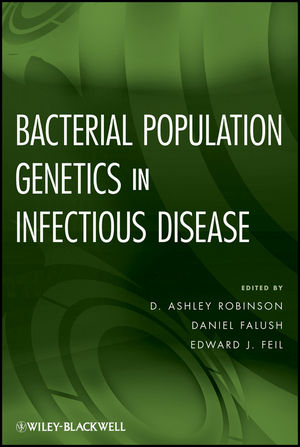Bacterial Population Genetics in Infectious DiseaseISBN: 978-0-470-42474-2
Hardcover
448 pages
April 2010, Wiley-Blackwell
 |
||||||
Preface.
Contributors.
Part I Concepts and Methods in Bacterial Population Genetics.
1 The Coalescent of Bacterial Populations.
1.1 Background and Motivation.
1.2 Population Reproduction Models.
1.3 Time and the Effective Population Size.
1.4 The Genealogy of a Sample of Size n.
1.5 From Coalescent Time to Real Time.
1.6 Mutations.
1.7 Demography.
1.8 Recombination and Gene Conversion.
1.9 Summary.
2 Linkage, Selection, and the Clonal Complex.
2.1 Introduction—Historical Overview.
2.2 Recombination, Linkage, and Substructure.
2.3 Neutrality versus Selection.
2.4 Clustering Techniques.
3 Sequence-Based Analysis of Bacterial Population Structures.
3.1 Introduction.
3.2 Alignments.
3.3 Phylogenetic Methods.
3.4 Measures of Uncertainty.
3.5 Beyond the Tree Model.
4 Genetic Recombination and Bacterial Population Structure.
4.1 Introduction.
4.2 Constraints on LGT.
4.3 Infl uences of LGT on Sequence Analyses.
4.4 The Detection of Individual LGT Events.
4.5 The Estimation of Homologous Recombination Rates.
4.6 Properly Accounting for LGT During Sequence Analyses.
4.7 Questions Relating Directly to LGT.
5 Statistical Methods for Detecting the Presence of Natural Selection in Bacterial Populations.
5.1 Introduction.
5.2 Natural Selection.
5.3 Statistical Methods for Detecting the Presence of Natural Selection.
5.4 Statistical Methods for Bacterial Populations.
5.5 An Example.
5.6 Discussion and Perspective.
6 Demographic Infl uences on Bacterial Population Structure.
6.1 Bacterial Population Size.
6.2 Measures of Genetic Diversity.
6.3 The Concept of Effective Population Size.
6.4 Inferring Past Demography from Genetic Sequence Data.
6.5 Population Subdivision.
6.6 What is a Bacterial Population?
6.7 Conclusion.
7 Population Genomics of Bacteria.
7.1 Introduction.
7.2 Classical Bacterial Population Genetics.
7.3 The Genomics Era.
7.4 Bacterial Population Genomics.
7.5 Next-Gen Bacterial Population Genomics.
7.6 Next-Gen Genomics Technology.
7.7 Next-Gen Genomic Data Analysis.
7.8 Conclusions/Future Prospects.
8 The Use of MLVA and SNP Analysis to Study the Population Genetics of Pathogenic Bacteria.
8.1 Introduction.
8.2 MLVA and Other DNA Fragment-Based Methods.
8.3 SNP and DNA Sequence-Based Methods.
8.4 Conclusion.
Part II Population Genetics of Select Bacterial Pathogens.
9 Population Genetics of Bacillus: Phylogeography of Anthrax in North America.
9.1 Introduction.
9.2 History of Anthrax in North America.
9.3 The Anthrax Districts after 1944.
9.4 Molecular Genotyping of B. anthracis.
9.5 Genotypes within the Anthrax Districts in North America.
9.6 Phylogenetic Resolution within the WNA Lineage.
9.7 Phylogeographic Resolution within the Ames Lineage.
9.8 Additional B. anthracis Genotypes in North America.
9.9 Conclusions.
10 Population Genetics of Campylobacter.
10.1 Introduction.
10.2 Human Infection.
10.3 Genetic Structure.
10.4 Models of Campylobacter Evolution.
10.5 Clades and Species.
10.6 Conclusion.
11 Population Genetics of Enterococcus.
11.1 Introduction.
11.2 Antibiotic Resistance.
11.3 Vancomycin Resistance.
11.4 VRE: A Zoonosis or Not?
11.5 Population Structure and Genetic Evolution: Similarities and Differences Between E. faecium and E. faecalis.
11.6 What Is Driving GD in E. faecium and E. faecalis?
11.7 The Accessory Genome of E. faecium and E. faecalis.
11.8 Summary, Conclusions, and Future Perspectives.
12 Population Biology of Lyme Borreliosis Spirochetes.
12.1 Introduction.
12.2 Genome Organization of LB Spirochetes.
12.3 Genotyping of LB Spirochetes and Phylogenetic Tools.
12.4 Population Biology and Evolution of LB Spirochetes.
12.5 Do LB Species Exist?
12.6 Future Research Avenues.
13 Population Genetics of Neisseria meningitidis.
13.1 Introduction.
13.2 A Brief History of Typing of Meningococci.
13.3 Species Separation.
13.4 Sampling Strategies.
13.5 The Clonal Complexes of Meningococci.
13.6 Forces Shaping the Meningococcal Metalineage.
13.7 Virulence, a Mysterious Trait.
13.8 Population Effect of Meningococcal Vaccines.
13.9 Antibiotic Resistance and Meningococcal Lineages.
13.10 Concluding Remarks.
14 Population Genetics of Pathogenic Escherichia coli.
14.1 Introduction.
14.2 E. coli Population Genetics: Clonal or not Clonal?
14.3 The E. coli Phylogenetic Structure.
14.4 The Evolutionary History of a Host-Specifi c Obligate Pathogen: The Shigella and EIEC Case Study.
14.5 What Makes You an Opportunistic Pathogen?
14.6 The Virulence Resistance Trade-off.
14.7 Concluding Remarks.
15 Population Genetics of Salmonella: Selection for Antigenic Diversity.
15.1 Introduction.
15.2 Generation Timescale Diversifi cation.
15.3 Antigenic Diversity in Salmonella.
15.4 Why Are Diverse H and O Antigens Maintained in Salmonella?
15.5 Conclusions.
16 Population Genetics of Staphylococcus.
16.1 Introduction.
16.2 Overview of The Staphylococcal Population Structure.
16.3 Staphylococcal Population Structure in Specific Disease Contexts.
16.4 Origin and Maintenance of Staphylococcal Genetic Variation.
16.5 Macroevolutionary Considerations and Concluding Remarks.
Appendix 1—Diversity and Differentiation.
17 Population Genetics of Streptococcus.
17.1 Habitats, Transmission, and Disease.
17.2 Classical Strain Typing.
17.3 Multilocus Sequence Typing (MLST) Based on Housekeeping Genes.
17.4 Species Boundaries and Gene Flow.
17.5 Niche-driving Genes.
17.6 Bacterial Population Dynamics and Selection.
17.7 Machinery of Genetic Change, Revisited.
18 Population Genetics of Vibrios.
18.1 Introduction.
18.2 V. cholerae.
18.3 V. parahaemolyticus .
18.4 V. vulnificus.
18.5 Conclusions.
References.
Index.



